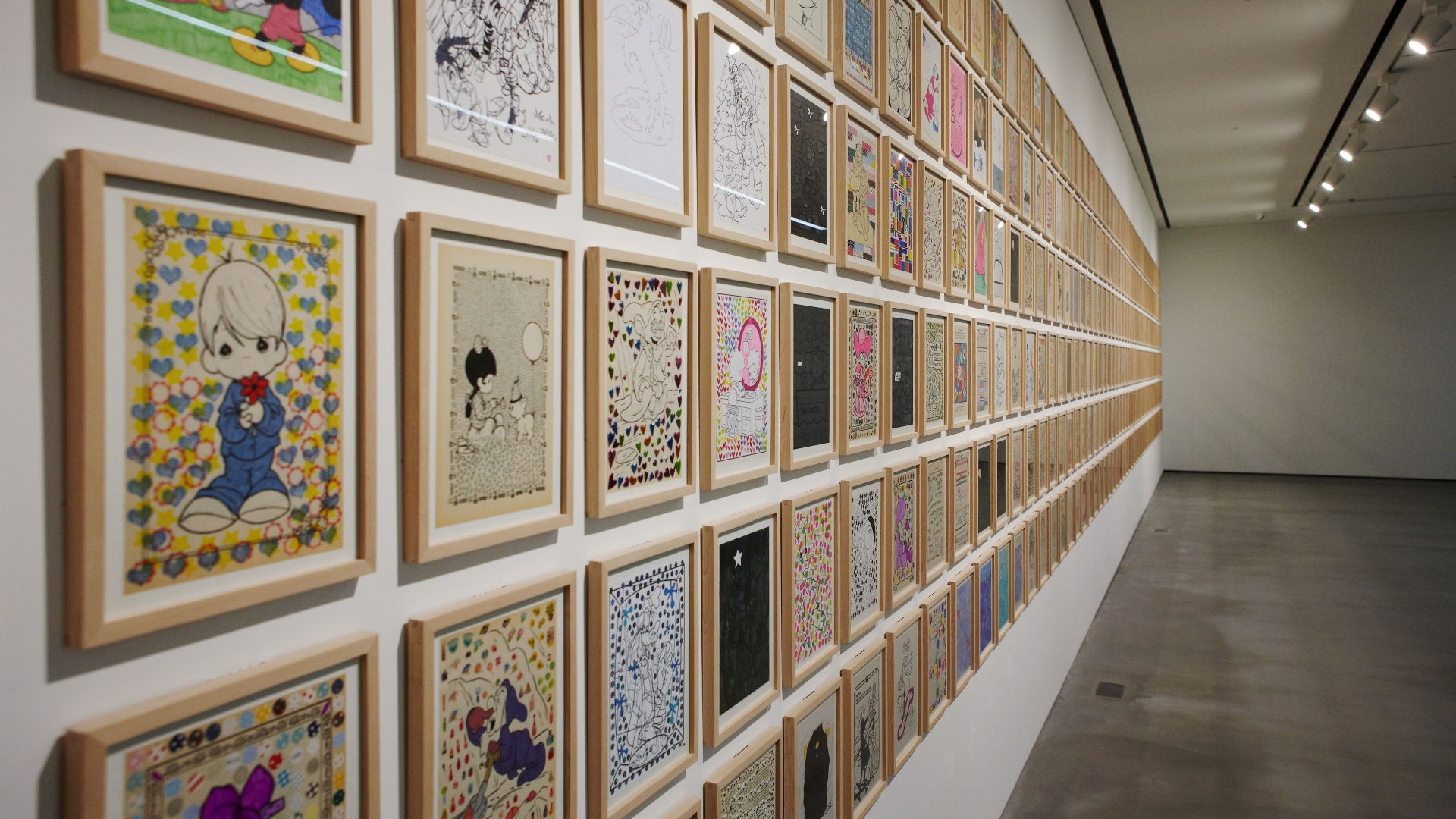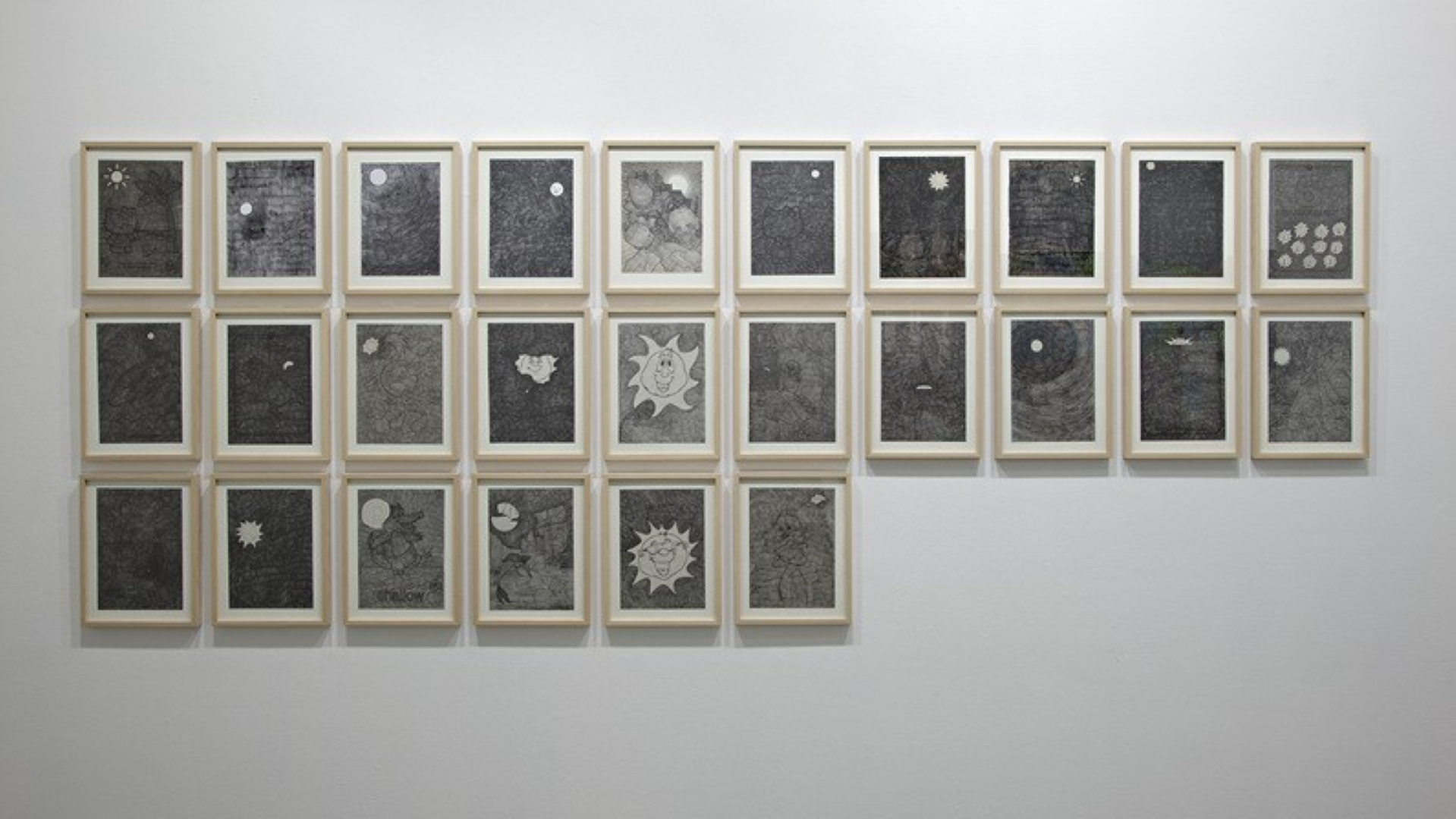- MeeNa Park explores the world of ready-made colors and shapes. Her work, characterized by an obsessive and autistic collection of study objects, followed.
© DOOSAN ART CENTER. All Rights Reserved.


Education
1999
M.F.A. Painting, Hunter College, City University of New York, New York, US
1997
B.F.A. Painting, Rhode Island School of Design, Providence, RI, US
Selected Solo Exhibitions
2024
Black, Perigee Gallery, Seoul, KR
2023
CV: MeeNa Park and Sasa[44], SeMA AA, Seoul, KR
ZIP, ONE AND J. Gallery, Seoul
Nine Colors & Nine Furniture, Atelier Hermès, Seoul, KR
2020
Why rain drop overlapped blue faces golden bear at the circus?, Audio Visual Pavilion, Seoul, KR
2019
SCREAM, Over the Influence Gallery, Hong Kong
2017
MeeNa Park: Artist’s Palette, Gyeongju Arts Center, Gyeongju, KR
2016
Scream, Audio Visual Pavilion, Seoul, KR
MeeNa Park: Artist’s Palette, SeMA Bukseoul Museum, Seoul, KR
2015
24 & 36 Grays, Gallery EM, Seoul, KR
2014
Grey & 12, Kukje Gallery, Seoul, KR
2012
Drawings 1998- 2012, DOOSAN Gallery, Seoul, KR
Gray Sky, DOOSAN Gallery New York, New York, US
2011
AZ, Gallery em, Seoul, KR
2010
BCGKMRY, Kukje Gallery, Seoul, KR
Selected Awards
2020
Ministry of Culture, Sports and Tourism Award, KR
2012
The 1st DOOSAN Yonkang Arts Awards Visual Art, DOOSAN Yonkang Foundation, KR

Jury's Statement
All of the nine nominees for the 1st DOOSAN Yonkang Arts Awards in Visual Arts have succeeded in firmly constructing their artistic worlds, and all were born between 1971 and 1974. During the process to select the final three, the single most important criterion was the excellence of the work, and there were some differences in opinions among three judges but these differences of opinion were not irreconcilable. The recipients are Donghee Koo (b. 1974), Siyeon Kim (b. 1971), and Meena Park (b. 1973), coincidentally all women. I am pleased that a new award is created to inspire artists in their late 30s. What all artists need is an opportunity to create their works. As the DOOSAN Yonkang Arts Awards provide artists with prize money including support funds for creation and an opportunity for a solo exhibition, it is inevitable to draw comparisons with the Hermes Foundation Missulsang (art award). I hope the DOOSAN Yonkang Arts Awards will be stably run and become a fair award system so that it can contribute to the development of the Korean contemporary art community. During the screening process, there were some opinions that “it was a little disappointing not to see unknown nominees.” But the emergence of totally unknown but competent rookies is not easy to find. Given the circumstances of the Korean modern art circle, it seems important to select and support established artists who try to intensify their art works, rather than blindly searching for new faces. Among major artists in their 40s, many, unbefitting of their reputation, have yet to hold proper exhibitions. Donghee Koo may seem like a “crazy film director” to those unfamiliar with her work. However, while her videos could qualify as independent feature films, they are closer to a type of simulation game for exploring the ecosystem of the heart, which, from its premise, parts ways with movies that are based on narratives. She always seems to complete illogical third-rate films, but each simulation game is programmed with major precautions and initial algorithms. The artist complies with or violates these conditions and rules during the filming process, and by succeeding to fail, she achieves unexpected outcome of capturing on film surprising and vagarious elements. Siyeon Kim installs within residencies specific shapes and images-cones, houses, patterns-made from powder-form materials including salt, soap, and washing powder. These installations are then photographed, and the resulting prints exhibited. Her works, though not ambitious, are distinguished by her poetic taste and method of discovering various psychological factors hidden in the ordinary spaces of a home. Kim, who has refrained from venting her feelings, unfolds an experimental theater of materials using an apartment’s residential space as a stage and material. How far can her experimental theater go? Meena Park explores the world of ready-made colors and shapes based on a series of research activities that she calls “pseudo-science.” Her work, characterized by an obsessive and autistic collection of study objects, followed by a repetition of mechanical labor on the collection, comments on the major forms of art history and captures specific aspects of capitalistic material culture. For example, a series of pen drawings, one of her minor endeavors, is significant in that it alters the line drawing methods of Agnes Martin and Sol Lewitt, and at the same time signifies a collection, of the ink colors of the ready-made pens, distributed today as products. What new works will these three artists show at the exhibition of DOOSAN Yonkang Arts Awards Recipient? I conclude my commentary by wishing for a wonderful exhibition. Congratulations to all the awardees.
_ Geun-jun Lim
As the DOOSAN Yonkang Arts Awards for Fine Art provide young artists with an attractive opportunity for a six-month stay to create and exhibit their works in New York City, we focused on selecting artists that are talented enough to make the best use of their sojourn in New York. In addition to that, considering various aspects such as a serious creative attitude, a strong conceptual vision, and a capacity for expression and experimentation in using various media, we narrowed down nine finalists to three awardees: Donghee Koo, Siyeon Kim, and Meena Park. Donghee Koo’s biggest appeal is that she competently and freely uses assorted media like photography, videos, and installation, showing the essence of “defamiliarization” in fine art. Her works with single-channel videos succeed in overcoming the tedium of the medium by creating an ambiguous situation where narratives are not significant, and offer, through ambiguity, a bizarre stimulating pleasure that awakens every single cell of the observer. Her installation works subvert conventional wisdom in many ways with their inherent tension even when appearing loose, and her way to robustly organizing conceptual layers is so outstanding that the viewer can experience the thoughts of the artist just as they find their way through a maze. In recent years, Siyeon Kim has been creating fantastic fairytale narratives with various materials and methods, which delicately touch on the emotions of joy, anger, sorrow, and pleasure, which every person possesses. One of her serial works featurese objects like cones made from ordinary materials such as salt and soap, and installed around a house, which Kim captures in black-and-white photographs, expressing complex emotions and irony of life, inherent in daily routines, from a distinctively female perspective. Such delicacy is her great strength, but at the same time, might become an obstacle she has to overcome in order to reach the next level in her artwork. If Kim seeks ways to more firmly build the conceptual structure of her art, while keeping her unique lyrical emotions, I believe she will grow into a great artist. Meena Park stands unparalleled among artists around the same age in forging direct relations with the world through painting. From her collection and classification of colors, and use of ready-made images to her recent Dingbat paintings, all of her works are an experiment at overcoming the formal limitations of painting as a medium. At the same time, they are organized in a clever way so that the colors and images make a self-referential statement to the world. She also displays excellence in her works that appear to be bright and cheerful, but in fact convey a cold analysis of the world by dealing with the distribution system from the production of colors and images to consumption. For this artist who uses collection as a significant motif in her works, a six-month residency in New York City will serve as a prime opportunity to create new work. I sincerely believe this award will serve as a foothold for these three artists to proceed to more interesting projects, and hope that the DOOSAN Yonkang Arts Awards will grow into a great driving force for the development of the Korean art community by providing talented young artists with opportunities to create and exhibit works in a new environment.
_ Yunah Jung
As all of the nine finalists here are actively producing works in the Korean fine arts community through their unique styles, it was very difficult for me to select only three. It was a challenge for me to keenly realize once again the limitations of the public contest system. I tried to address such difficulty by selecting those who not only prove their excellence but match up with the direction and theme of this supporting program. First, the supporting program of the DOOSAN Yonkang Arts Awards is designed more for overseas promotion than domestic promotion. Art pursues experimental values on the premise of diversity. In the 21st century when the boundary between local and global areas is meaningless, experimental nature is not limited to only the creativity of the local culture. In the context and images of their work, these three selected artists effectively convert the differentiated creativity of local areas into a common language every human can feel. While interpreting their works, there is relatively little misunderstanding that might be caused by differing cultural backgrounds between local and global areas. Second, this program does not focus on short-term results, or exhibitions, but includes the entire process of creation including residencies, publications, and workshops. In this sense, I have selected three artists that have linked their lives to society, studied the process of mutual relations, and accordingly improved their works. I have also tried to choose those who are able to adapt themselves to a new area and environment while they plan and realize new projects. I have kept in mind the possibility in which they could break free from merely expanding upon their existing works, and attempt to make changes and meet greater challenges. All of the nine finalists are actively creating works in the fine arts circle and are directly or indirectly connected to me, so I had no difficulty in understanding their erstwhile works. But because each of them is producing considerably experimental work, it was difficult to apply conventional standards of evaluation. Therefore, I once again would like to mention that I have selected artists that are more suitable for the direction in which DOOSAN is heading. I hope that these artists will have opportunities to showcase their talents to the international fine arts community by answering the call of this supporting program.
_ Jinseok Seo